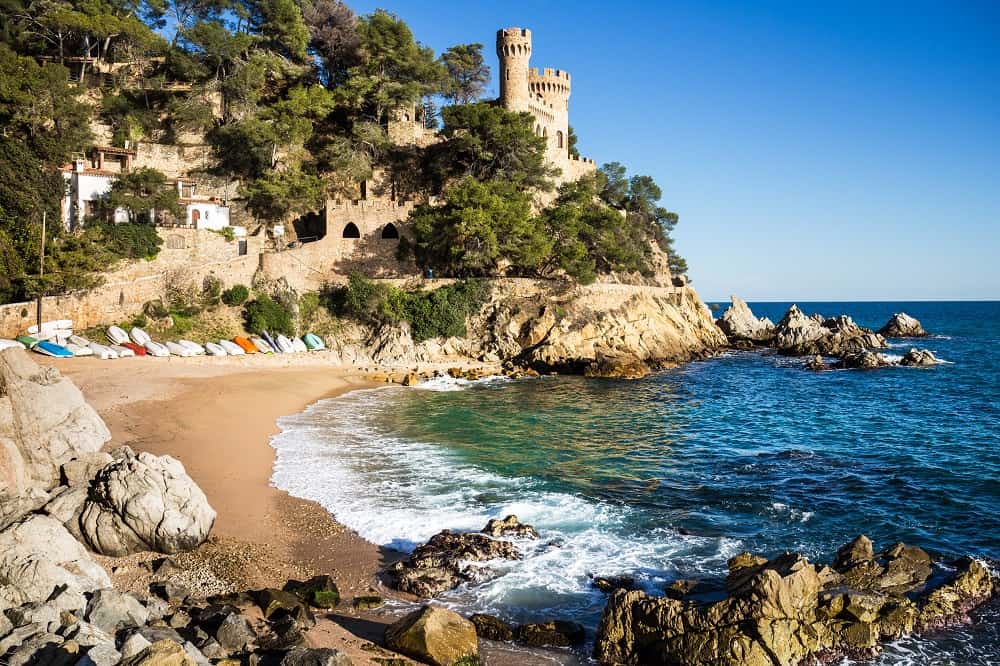
Lloret de mar is known as a vibrant party city where young people can go crazy in the middle of summer. Lloret de Mar, however, has Sun, sea and beach so much more. If you look a little further than the big picture, you will quickly conclude that in Lloret de Mar you can also experience the typical Spanish culture in a great way. In and around Lloret de Mar, you will find a lot of see sights and monuments which are an important part of Spanish history and culture. So you have there beautiful castles, Iberian settlements, statues, churches and other historical monuments that offer the perfect variety in addition to relaxing beach days.
Do you want to know which important buildings and monuments in Lloret de Mar you should not miss during your holiday in Lloret, then read on.
Look here for the Highlights in Lloret de Mar!
The rich history of Lloret de Mar
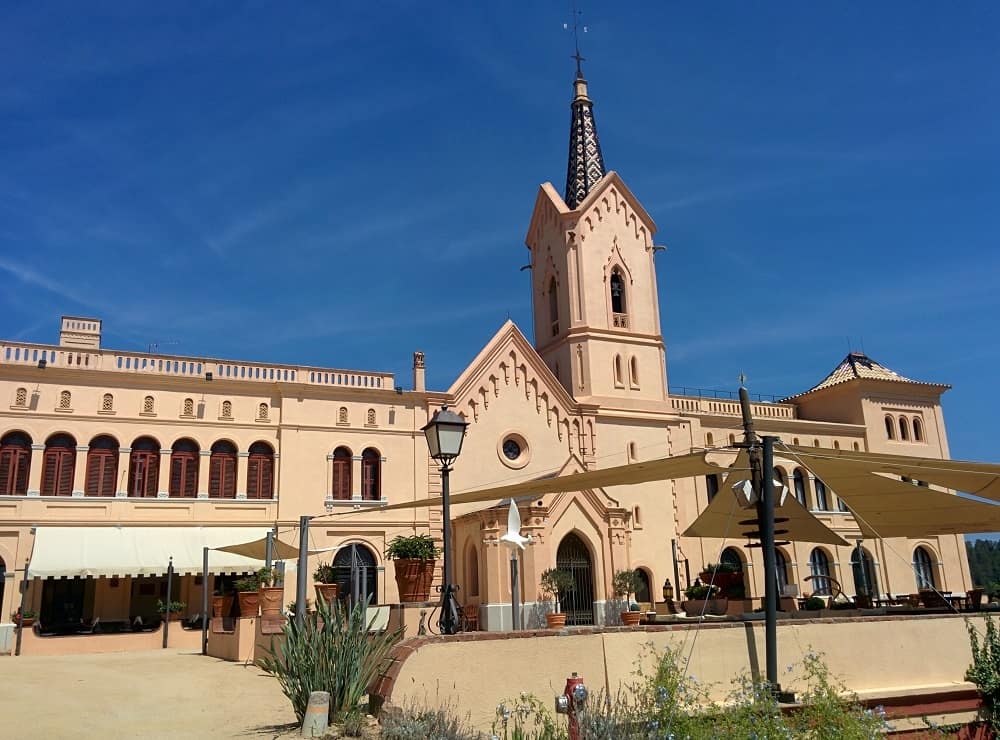
The history of Lloret de Mar starts around the 3rd to 4th century BC. The proof for this can be found at the 3 settlements in and around Lloret de Mar: Puig de Castellet, Montbarbat and Turó Rodó. The ruins are about 2300 years old and played an important role during the Punic Wars. The old ruins were excavated in 1943 and are therefore from great historical value. Being another important part of the history in Lloret the Middle Ages. At this time, Lloret de Mar mainly consisted of farmhouses, an old Romanesque church Sant Romà and the tower of Sant Joan, which you can still see today.
Thanks to the tower's protection against attacks from the sea, an increasing proportion of the population moved after the coast and slowly formed the Lloret de Mar as we know it today. The most important part of the history of Lloret de Mar, however, is the decree of free trade with the American colonies that King Charles III of Spain issued in 1778. Many residents subsequently decided to go to America in search of the big fortune, then return to Lloret de Mar with this fortune and invest in large houses and monuments in the city. Today this group is commemorated as the 'Indianos' or' Americanos".
The most beautiful 12 monuments in Lloret de Mar!
If you are in Lloret de Mar then, with this beautiful and rich history in mind, it is definitely worth a tour through the history of Lloret de Mar. See the settlements of the Romans, the beautiful buildings from the Middle Ages and the countless monuments in Lloret de Mar from the Spanish empire. Below we have made an overview of the most beautiful monumental buildings and monuments in Lloret de Mar:
1. Castell de Sant Joan
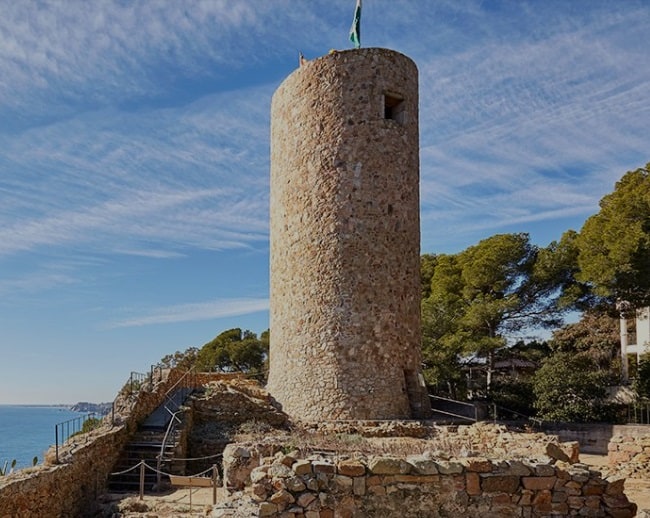
The Castle of Sant Joan (Castell de Sant Joan), located on a high cliff between the main beach of Lloret de Mar and the beach of Fenals (direction Blanes), is one of the oldest monuments in Lloret de Mar. The fort was built in the 13th century, but its famous tower (to protect the city from pirates) was built as early as the 11th.th century built. Although unfortunately little remains of the castle, some of the ruins were restored from 1960 to 1992. For example, you can climb the Tower of Tribute, which offers a great view of Lloret de Mar and the Costa Brava.
Location, opening hours and price:
- Address: Punta de Fenals, Lloret de Mar.
- Contact: +34.972.36.57.88
- Opening hours: from November to March, open on Saturday, Sunday and public holidays from 10 am to 2 pm. Open daily from April to October from 10 am to 1 pm and from 5 pm to 7 pm.
- Entrance fee: The entrance fee to Castell de Sant Joan is € 3 for adults. For pensioners, minors, large families and disabled people, a reduced price of € 1.50 applies.
You will find more information about the castles in Lloret de Mar. here!
2. Modernist Cemetery
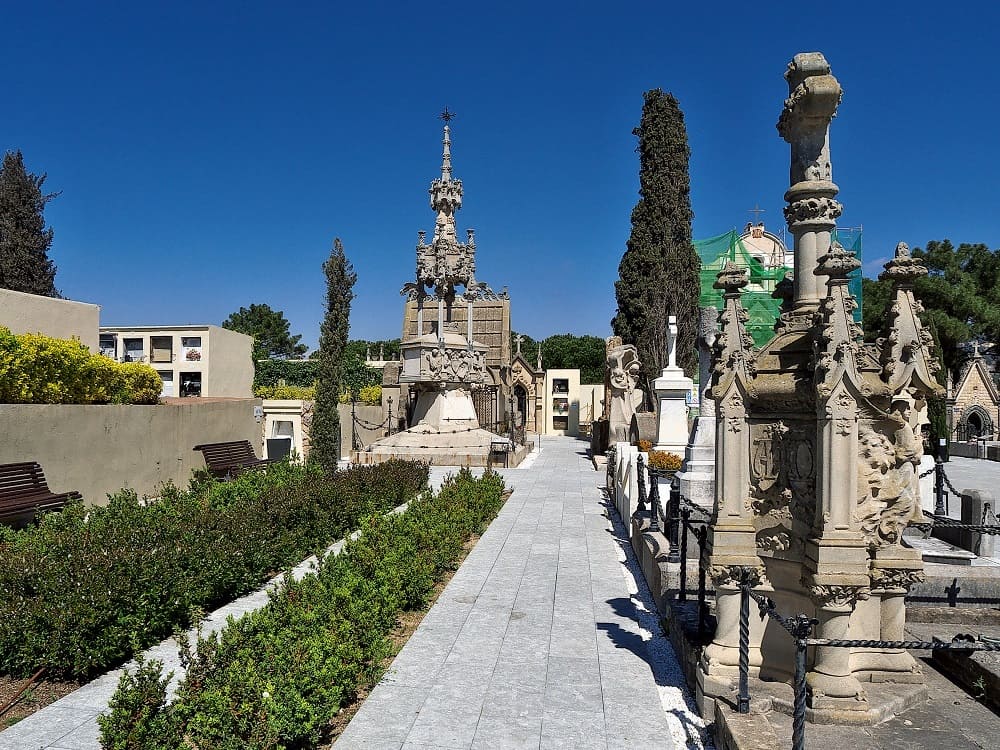
A cemetery may not be the first thing on your mind for a fun day out, but the modernist cemetery in Lloret de Mar is well worth a visit. It dates from the late 19th/ early 20sth century and is also called the “Indianos cemeteryNamed after the native of Lloret who made their fortunes in the Spanish colonies and had beautiful houses and tombs built upon their return. The graceful architectural style is typical for Catalan modernism and the Modernist Cemetery is a wonderful example of this.
Location, opening hours and price:
- Address: Camí del repòs, Ctra. Blanes (200 meters from St. Quirze), Lloret de Mar
- Contact: +34.972.34.95.73
- Opening hours: open daily from 8am to 8pm from April to October. The cemetery closes at 6 pm from November to March
- Access: Free - The modernist cemetery is part of the Lloret de Mar Open Museum
3. The 3 Iberian archaeological settlements of Lloret
As said, the history of Lloret de Mar goes much further back. There are around the city some excavations of Iberian settlements that are almost 2400 years old. Of course you do not have to visit them all during your holiday in Lloret de Mar but it is definitely recommended to take a look at one of these 3 monuments in Lloret de Mar and to take you back in time.
Turó Rodó
Turó Rodó is a small village dating from the 3rd century BC. Archaeological remains found here suggest that the settlement served both as a lookout point and as a commercial center for trade with other villages around the Mediterranean. See how the first inhabitants of Lloret de Mar lived in a replica of an Iberian house of the time, built with authentic methods and materials.
Location, opening hours and price:
Address: Camí de Ronda de Lloret a Canyelles, 17310 Lloret de Mar
Phone: +34 972 365 788
Opening hours: from October to May, open on Saturday, Sunday and public holidays from 10am to 2pm. Open all week from 10am to 1pm and 5pm to 7pm from June to September.
price: € 3 adults, € 1.50 reduced
Puig de Castellet
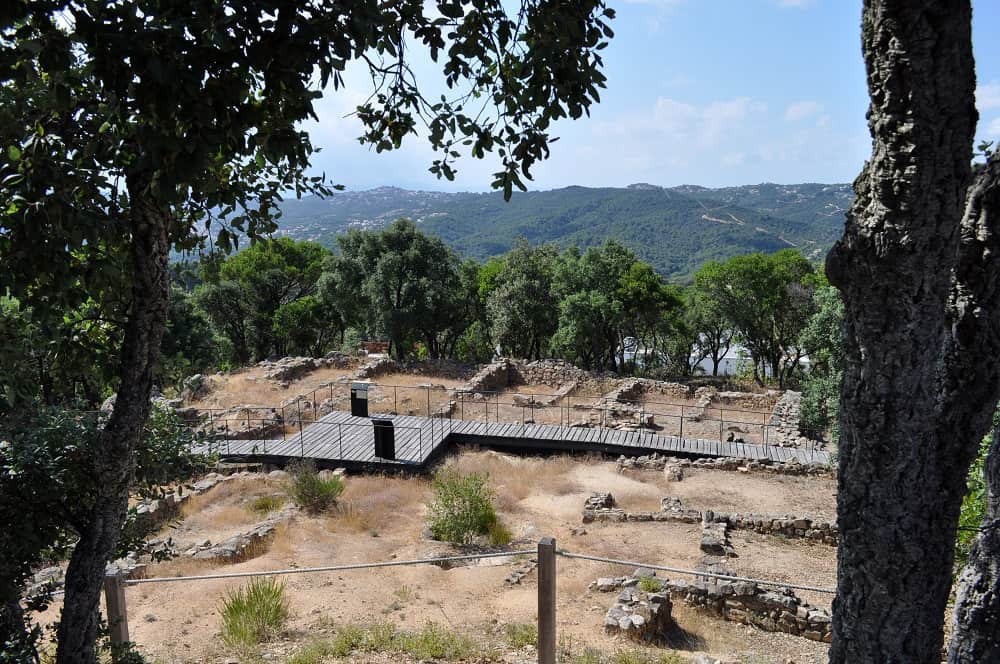
The archaeological excavation of Puig de Castellet, an old and small settlement with about 6 houses, is located only 2 km from the center of Lloret de Mar. Puig de Castellet played an important role during the Punic Wars and probably served as a military lookout and defense after all. In addition to the fact that this is a fun and educational cultural outing, you can also enjoy a panoramic view of Lloret de Mar and Blanes.
Location, opening hours and price:
Address Urbanització Roca Grossa C. / Poblat Ibèric, 17310 Lloret de Mar
Phone: +34 972 365 788
Opening hours: from June to August on Saturday from 17:00 to 19:00
price: € 3 adults, € 1.50 reduced
Montbarbat
Montbarbat is the largest Iberian settlement of Lloret de Mar with an area of 5,700m2. However, it is also the furthest from the city (7 kilometers from the center). Several streets and buildings have been excavated here, and there are also some fragments of imported Attic pottery that can be found it. However, as the excavations are still ongoing, it is unfortunately not currently open to visitors.
Location
Address: Urbanització Masies de Lloret, 17310 Lloret de Mar
Phone: +34 972 365 788
4. La Dona Marinera
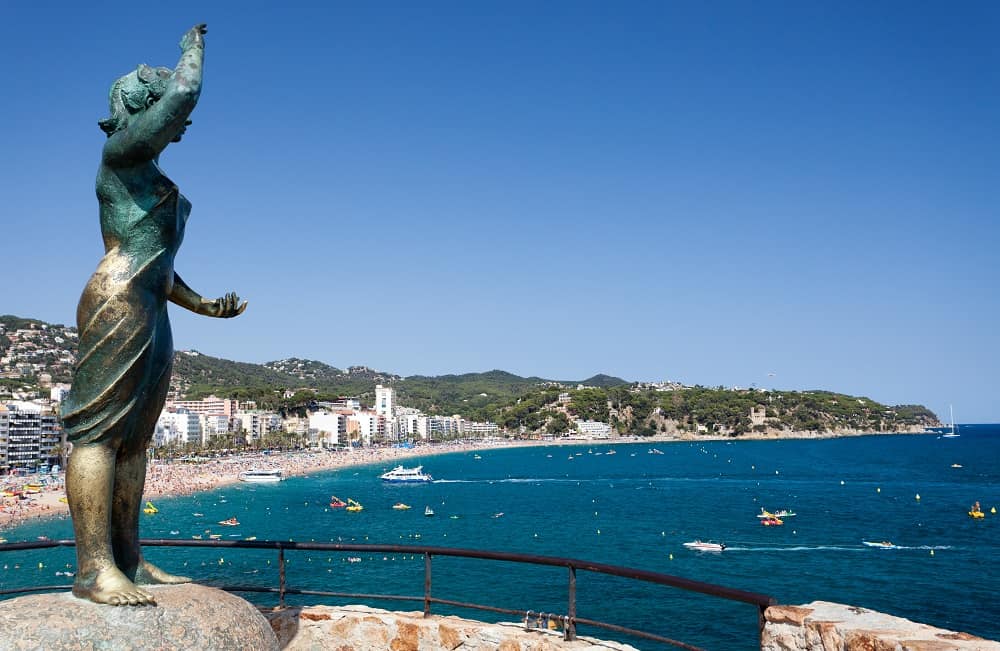
The statue of the Fisherwoman (La Donna Marinera), one of the most iconic symbols of Lloret de Mar, has adorned Lloret de Mar beach since 1966. The graceful bronze statue is a tribute to the women of the fishermen who were left for centuries while their husbands tried their luck in the Mediterranean. Because this beautiful monument in Lloret de Mar is so elegant, it has been nicknamed “Venus of Lloret”. Legend says that she even brings good luck! Make a wish while touching her right foot and looking towards the horizon and then La Dona Marinera will make it come true.
5. L'Esguard Monument
On the boulevard of Lloret de Mar you will find bronze with steel statue L'Esguard. The monument, which symbolizes both a football and a globe, was placed here on October 15, 2000 as memory of an international meeting of FC Barcelona Supporters Clubs. A special piece of history. The L'Esguard monument in Lloret de Mar is especially nice to admire for football fans who are fond of Barcelona.
6. Sardana Monument
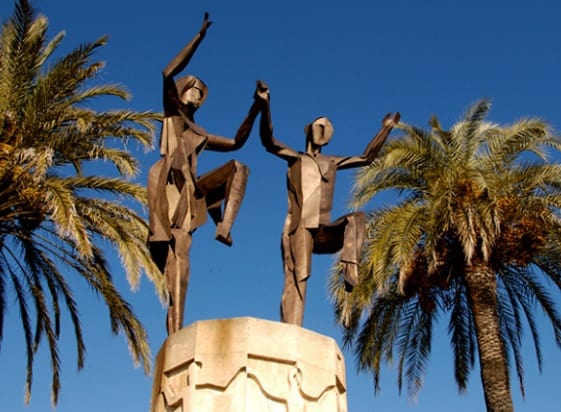
On the other side of the beach of Lloret, also on the boulevard, there is still a "sporty" statue. The Sardana monument represents a man and woman who dance the traditional Catalan dance, sardana, . In 1971 Lloret de Mar became an official Sardana Heritage Town, where the culture and tradition of the sardana is honored. To celebrate that, the municipality had this image made.
7. Apollo and Daphne Monument
The statue of Apollo and Daphne, made on the basis of Bonaventura Ansó from Girona, is one of the newest and most beautiful monuments in Lloret de Mar. It was unveiled in 2001 during the Millennium Celebration. The monument consists of different images and different materials and told the legend of Apollo and Daphne, which gives the city its name.
8. Nicolau Font Monument
Nicolau Font i Maig was an Indiano, a native of Lloret de Mar who had become rich in the Cuba. When he returned to Lloret, where his brother was the mayor, he bought an estate and left here the monastery of Sant Pere del Bosc restoration in the modernist style. After his death, his relatives had a monument erected for him in 1911. This statue of Nicolau Font is on top of the crypt in which he is buried in front of Sant Pere del Bosc.
9. Angel de Lloret
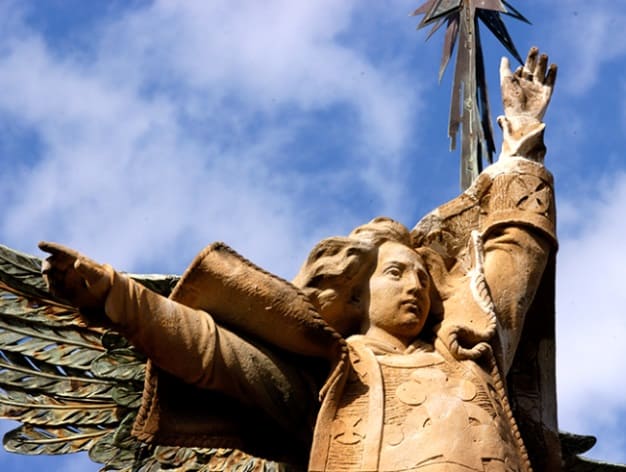
About 5 km from the center of Lloret de Mar, surrounded by nature, you will find originally a 10th century built Benedictine monastery, Sant Pere Salou“. Today the former monastery serves as a luxury Spa hotel & restaurant where you can enjoy a delicious lunch or dinner. After the monastery fell into disrepair, it was completely restored in the 19th century by order of Nicolau Font. In 1904 a column was built next to the chapel on which an angel, the Angel de Lloret (the Angel of Lloret).
The angel monument was built in 1904 and depicts an angel holding a metal star. This beautiful monument is a tribute to the poet Jacint Verdagueren, in the pedestal you see the face of the poet and an inscription of one of his poems.
10. Can Garriga
Can Garriga, located on the promenade of Lloret de Mar, is one of the most important 'Indiano' houses in Lloret de Mar.. Twenty-two years after leaving for America, Enric Garriga managed to return to Lloret de Mar in 1887 with a significant fortune. On his return, he decided to have this beautiful house built for his wife and seven children. The house remained family owned until 1981, until it was acquired by the city government.
Today this prominent home, along with the adjoining property, is the home of the Maritime Museum. Here you can learn all about the history and connection that Lloret de Mar has with the sea. During your journey through the various rooms in the museum you will discover the history of the city. You will pass the time that the ships were built on the beach, but also that the shipmen left for America for the tobacco, coffee and cotton trade. On the ground floor, the original ceilings, walls, furniture and floors from the 19th century have been preserved.
Location, opening hours and price:
Address Passeig de Camprodon i Arrieta, 2, 17310 Lloret de Mar
Phone: +34 972 36 44 54
Opening hours: Monday to Sunday from 9:00 AM to 1:30 PM and from 4:00 PM to 6:00 PM.
price: The entrance fee is € 4 for adults. Pensioners, minors, large families and disabled people have a reduced price of € 2.
11. City Hall (El Ayuntamiento)
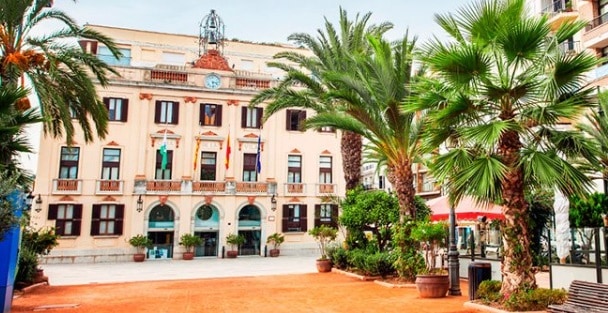
On the western side of the boulevard you will find the monumental building El Ayuntamiento built in 1872, also known as Casa de la Villa . Today, this beautiful building serves as the town hall, but owes its roots to the so-called 'Indianos' or 'Americanos'. The inhabitants of Lloret who died in the 19th century returned from America with great fortunes! This beautiful monumental building, built in modernist style, is definitely worth a look!
As indicated, in the 18th century many residents of Lloret de Mar started to try their luck in America. The “Indianos” or “Americanos” had many extravagant villas built on the shoreline in the typical Modernista style on their return to showcase their newly acquired wealth. So are you busy with a beautiful walk on the boulevard of Lloret de Mar., see if you can find more of these typical houses! You can recognize the buildings by the windows with stained glass and the graceful pillars.
12. Font de Canaletes
Located on the boulevard in Lloret de Mar, in front of the Town Hall (El Ayuntamiento) you will find the beautiful fountain “Font de Canalates. This fountain is an exact replica of the eponymous fountain on the Rablams in Barcelona. The fountain was donated by Barcelona to Lloret de Mar in 1968 and symbolizes the connection between the two cities.
If you want to know more about the sights in Lloret de Mar, read on: the 23 best sights in Lloret de Mar.
************************************
Do you also want to enjoy a wonderful holiday in Lloret de Mar, full of sun, sea & beach, going out, endless activities from your private villa? However, are you not sure where to start and how best to approach it? Then take a look at this 21 Tips for the ultimate holiday in Lloret de Mar!

